Writing ‘beat to beat’
It can be difficult to write a longform story. How much do you need to write before you can start drawing? How do you keep a story moving without getting bogged down in details? Can you write week-to-week without falling behind? Let’s talk about one way that you can plan your story ahead of time and continue writing as you’re producing pages.
Start with a structure
It’s easy to get bogged down in details when you’re writing. And if you’re not careful, that can result in a story that meanders and wanders. So I suggest starting with a story structure. I’m a strong proponent of using a sitcom structure to plan out a 22-page comic. Simplified, it looks like this:
- Pages 1-3 — Establish the main protagonist and the Goal or Quest. In other words, what is the hero trying to accomplish?
- Pages 4-5 — Story A: Protagonist tries to accomplish Quest and fails.
- Pages 6-8 — Story B: Subplot is introduced. A second protagonist is presented and a second Quest. This second Quest may or may not be related to the main Quest). Ina Seinfeld-style story, these two Quests would intersect at the end of the story.
- Page 9 — Story A: Protagonist tries again, and fails — or he/she meets new obstacles.
- Pages 10-12 — Story B: The secondary protagonist tries to achieve the secondary Quest, and also fails/meets new obstacles.
- Page 13 — Story A: We check in to see the progress. More fails.
- Page 14 — Story A: re-establish (and possibly re-state) the main Goal — emphasize its importance/significance.
- Pages 15-17 — Story B: Secondary storyline is tied up. The Goal is either reached or lost for good. Or, the real victory is in a side-goal. In any event, the subplot is now settled. Page 17 can either be the climax or a transition scene back to Story A.
- Pages 17-18 — Story A: Climax. The Quest is at an end, Our main protagonist has either succeeded or failed spectacularly. Perhaps the Quest of the subplot has had an effect on this main Quest.
- Pages 19-20 — The fallout. What are the repercussions of all of this? Where does the storytelling leave our characters? What are the new (if any) relationships that are formed? If nothing new is achieved, we simple show the characters settling back into Square One so they can be thrown to the wolves next time.
If you’d like, you could use a different structure — like the Hero’s Journey or the Story Circle (explained below).
The important thing is this: It’s helpful to have a structure against which you can build the story you’re writing. In other words, this is not an open-ended process. You’re going to devote a predetermined number of pages to each section of the story. Knowing this in advance will keep your writing moving along at a brisk pace — something your readers will appreciate.
Determine the basics
A story is a character who has a Want or a Need,
The ButSo Method
and faces an obstruction.
I call it the Butso Method of writing. it’s an oversimplification, but the basics are there. Sometimes, the protagonist isn’t being blocked at all, for example. Sometimes it’s a race to see who can get to the want/need first. Sometimes, a hero starts with a want but then discovers a need. But, overall, if you don’t know how to fill in that formula above, then you don’t know what your story is about. In some cases, you may even surprise yourself — discovering that a story that you thought was about Character A is actually Character B’s story!
Here’s a page from my sketchbook. I was plotting out a new chapter. As you can see, I had a number of possibilities for the Story A plot. Story B was already locked in.
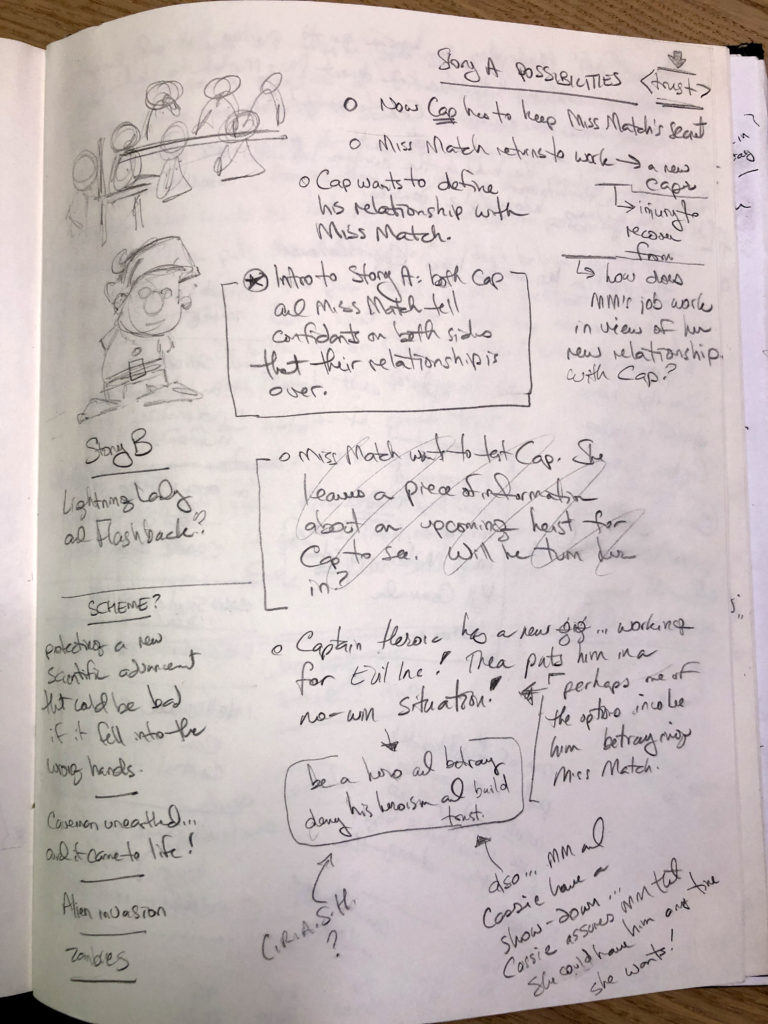
Once I solidified the central want/obstruction for each story, I could write — in general terms — how the story was going to progress. This is no time to get bogged down in details! (However, if there are some story points that are crucial, it’s wise to jot them down so you don’t forget.) This might be as simple as this:
- Character has a want.
- Character tries to get want.
- Fails.
- Character tries again.
- Fails.
- Discovers a secret.
- Tries a third time.
- Success!
- Character learns a lesson.
Apply the story to your framework
Next, it was time to rough the story into my structure. Remember, my story structure allots a number of pages to each section of the story. So, for example…
Pages 1-3 — Establish the main protagonist and the Goal or Quest. In other words, what is the hero trying to accomplish?
I had three pages to establish my main protagonist, the want/need, and introduce an obstruction. Here’s how that looked in my sketchbook:
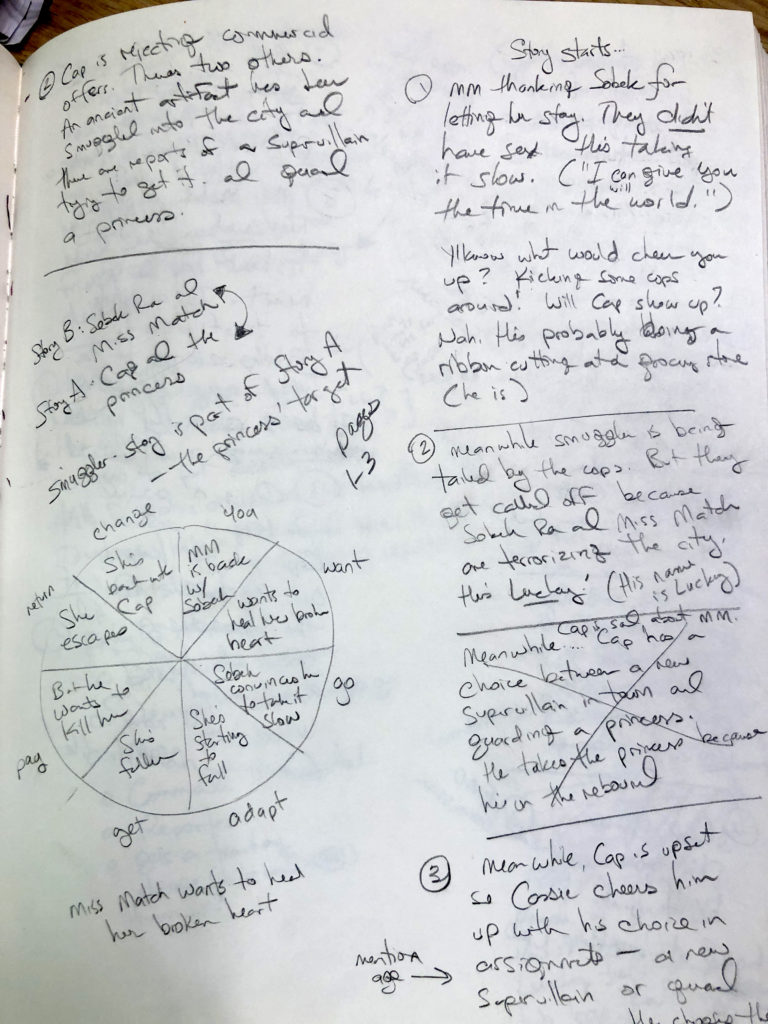
(As you can see, I was also experimenting with some Story Circle concepts as I wrote this chapter.)
Next, I go through the rest of my outline and fill in Story Beats.
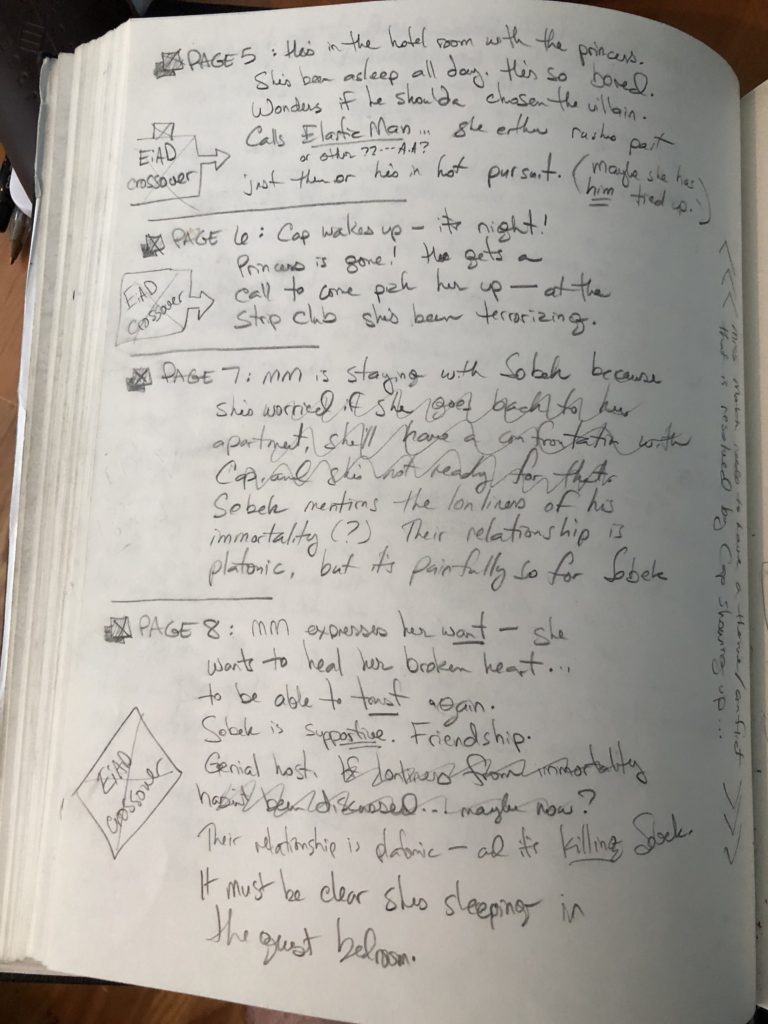
You’ll notice that some pages have several plot points mentioned — like Page 5. Other pages might be relatively light on details. For example, the page that’s staring me in the face today says: “Lightning Lady and Flashback get closer over breakfast. We learn something from Lightning Lady’s past?” I kind of hate it when I do that to myself. But it was important — in the moment in which I originally wrote that sentence — that I didn’t get too bogged down in the details. The objective for me then was to attach the story to the structure, and make sure I had a way to resolve all of the plot points by the end of the chapter. The objective for me now is to figure out what happened at breakfast.
Past You has to have infinite trust in Future You for this to work.
And if that trust is well-placed, you can now start working on comics pages even though you haven’t written a single scene.
Writing on the fly
The central strength of this approach is that — once you’ve come this far — you can now begin working on executing comics pages even though you haven’t finished writing yet. You can push ahead with the writing as far as you’re able, of course. But if you’re still working on some of the elements for later in the story, you can just concentrate on the story beat for the page you’re working on right now.
Let’s take Page 5, above, as an example. The story beats that need to happen here are laid out in a couple sentences: [Captain Heroic] is in the hotel room with the princess. She’s been asleep all day. He’s so bored. Wonders if he should have chosen [a different bodyguarding assignment]. Calls Elastic Man. She [ a new villain, Vybe] rushes past just then or he’s in hot pursuit. (Maybe she has him tied up).
It’s a bare-bones structure for the next page in the comic. And it’s all flexible. Here’s how it played out in my sketchbook:
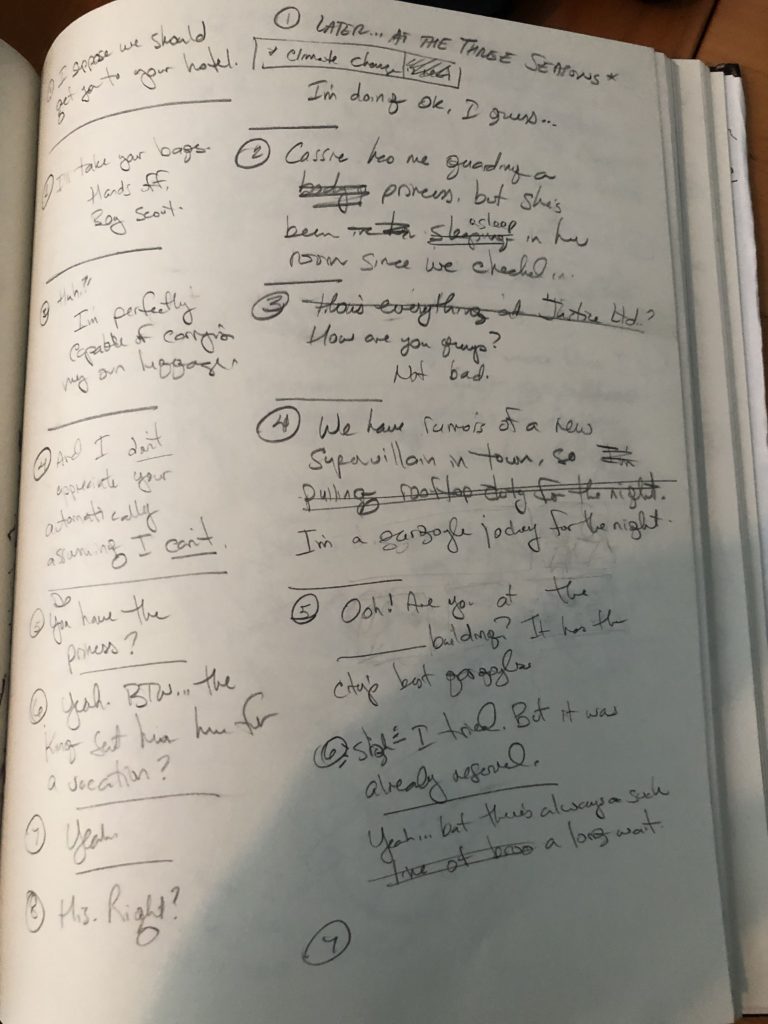
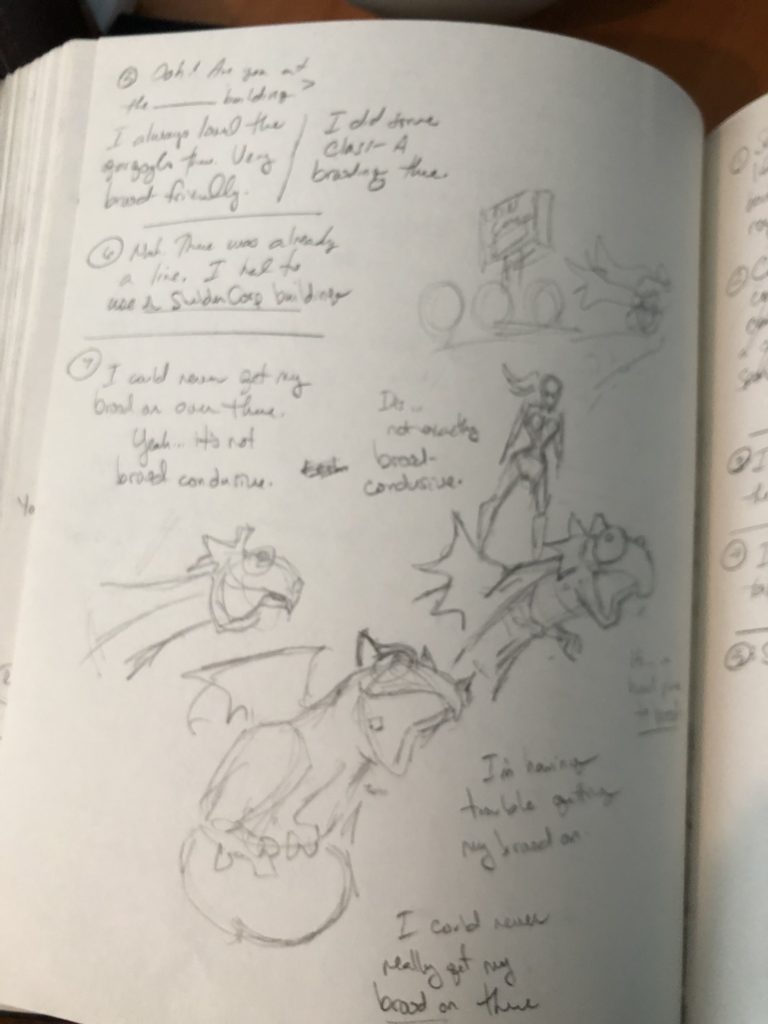
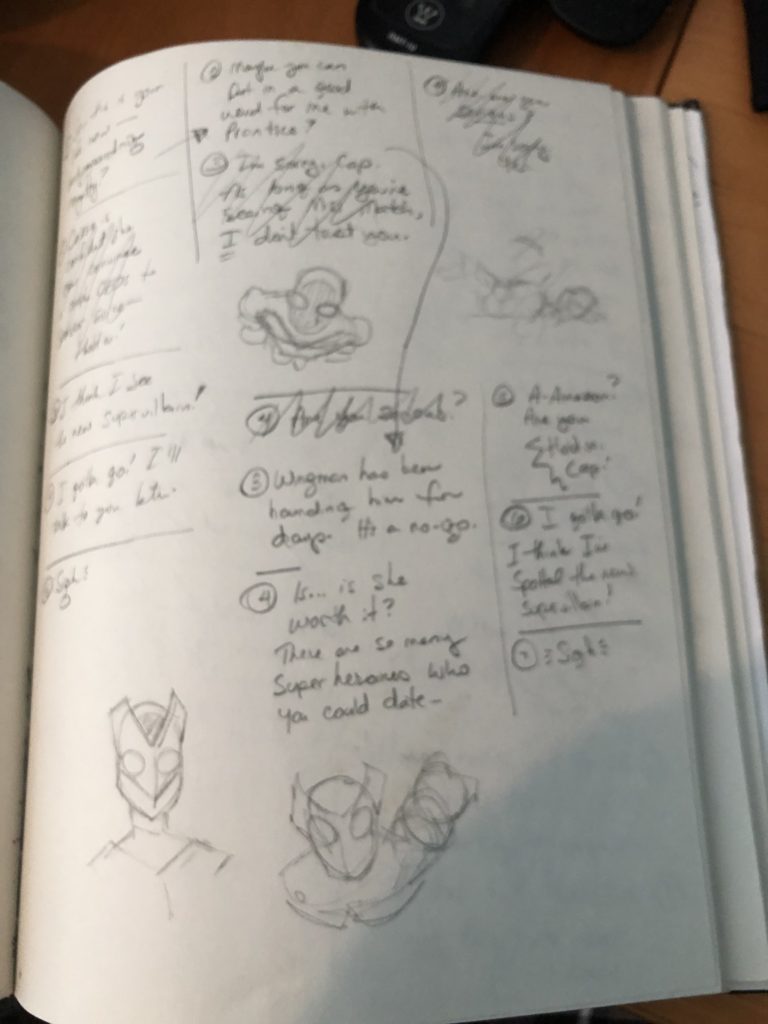
Originally, it was a very different scene. The person on the other phone was supposed to be Elastic Man — not Amazing Amazon. And we don’t even know the princess is gone yet. But the important beat — Cap is at the hotel room, thinking he’s with the princess, and meanwhile a supervillain is spotted — that’s what’s at the heart of this page.
My only job, once I had my beats worked out, was to make each beat as interesting as possible — even if that meant making small changes along the way … as long as those changes didn’t impact future story elements. For example, I saw a perfect opportunity to create some romantic tension between Amazing Amazon and Captain Heroic. So I replaced Elastic Man with the female superhero. It’s a plot point that won’t pay off this chapter — or even next chapter — but it’s going to be useful eventually. More importantly, it added some much needed narrative tension to the page.
Here’s the result:
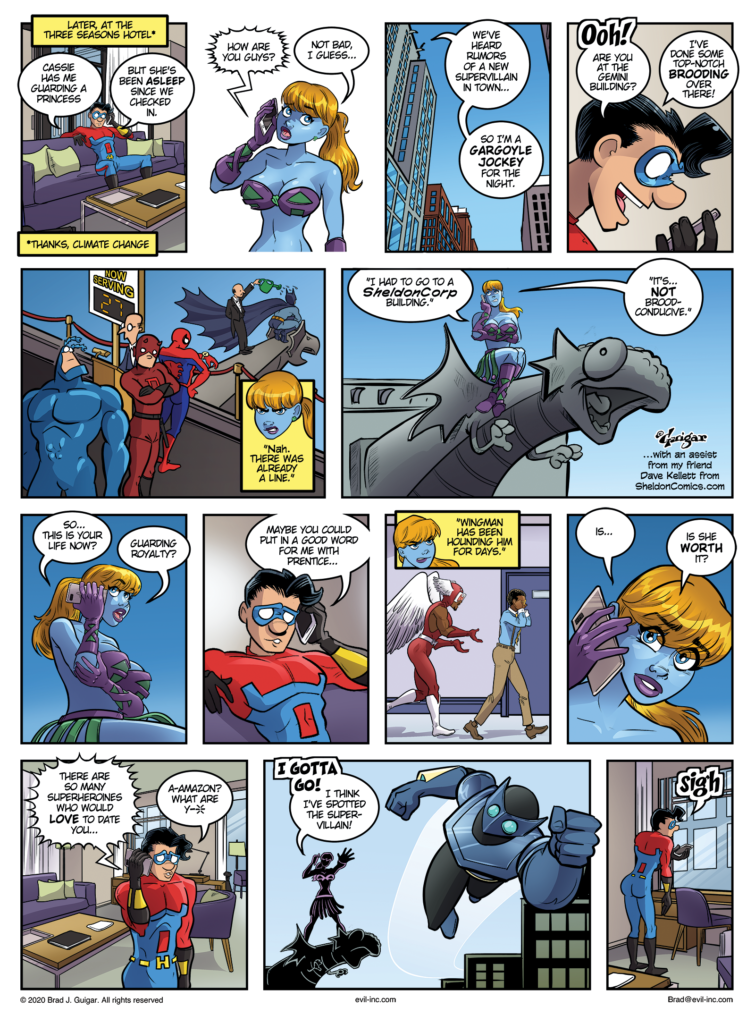
Pay attention to everything that evolved as I actually started writing that page. Most of what makes this page special were “unplanned.” In other words, they didn’t materialize until I actually started working on that page. Along with the last-minute introduction of Amazing Amazon, we have the main source(s) of humor for the page. The concept of a superhero using the term “gargoyle jockey” plays off the often-used visual of a superhero perched on a gargoyle, overlooking a city as he broods over hero stuff. It turned into a nice punchline — the panel with the heroes lined up for gargoyle reservations — along with a stinger in the next panel.
If I go back to an even earlier draft from the one I shared above, you can see that Page 5 started out very, very differently.
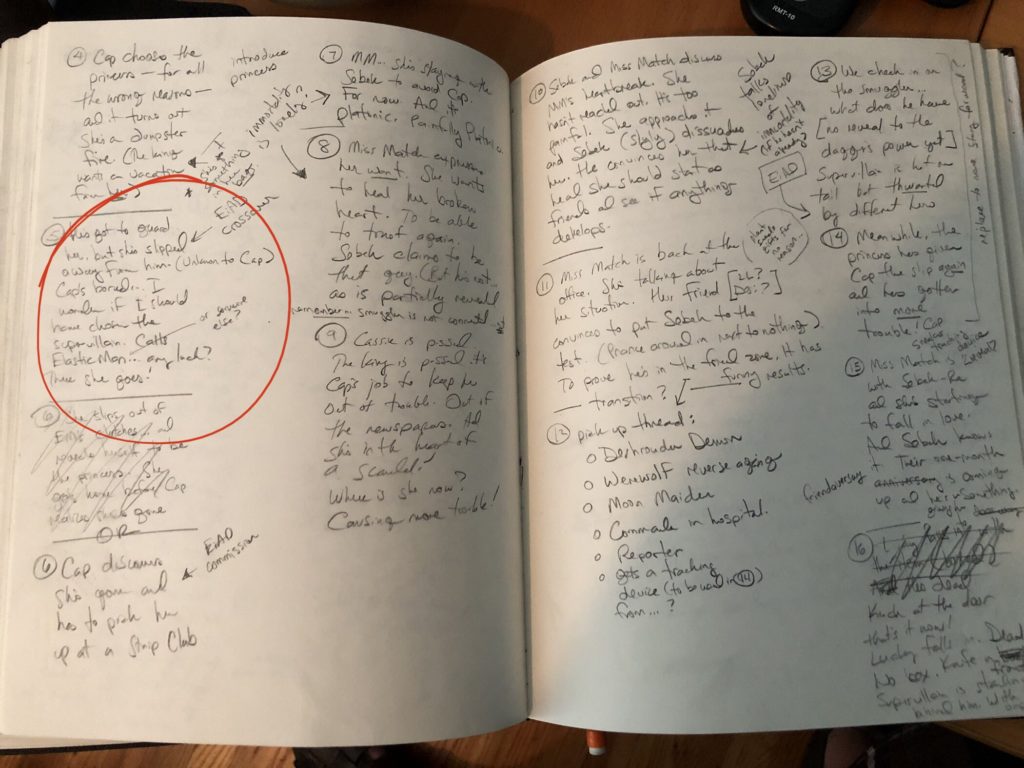
After you’ve finished the current page, you begin working on the next one, and the process starts all over again. You refer to the outline you’ve written against your story structure. Every couple of days (or weeks) you scan ahead to refresh your memory about upcoming story beats and look for anything that needs to be adjusted now that you’ve filled in details for the pages you’ve finished. In your downtime, you can start brainstorming your next chapter. But, most importantly, you can continue to release pages for your readers, even though you haven’t finished writing yet.
And that’s a crucial part of building — and keeping — an audience.




Recent comments